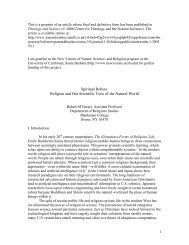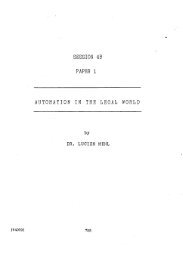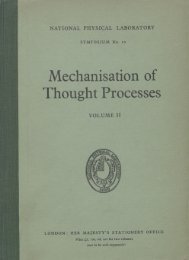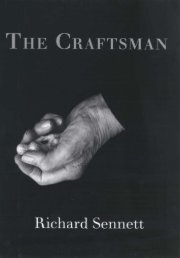ARTIFICIAL INTELLIGENCE
ARTIFICIAL INTELLIGENCE
ARTIFICIAL INTELLIGENCE
Create successful ePaper yourself
Turn your PDF publications into a flip-book with our unique Google optimized e-Paper software.
A Three-Part Thematic Structure of A.I.: Artificial Intelligence<br />
Introduction<br />
Stanley Kubrick labored for years trying to get the screenplay for his A.I.: Artificial Intelligence<br />
into shape. The film-to-be used the short story “Super-Toys Last All Summer Long” by Brian<br />
Aldiss as a starting off point. Kubrick employed a series of writers over the years to help him,<br />
including science fiction author Ian Watson. Different scenarios were conceived, yet the basis<br />
remained lodged in the Aldiss story.<br />
The Aldiss story (of a little less than 3,000 words) concerns the human characters Monica and<br />
Henry Swinton; David, a synthetic life-form manufactured to look like a human boy; and<br />
Teddy, a motorized teddy bear with a computer brain. The story takes place in an overcrowded<br />
world regulated by population control. Monica, having been refused the right to conceive a<br />
child, has tried to love David as a child surrogate, but she has remained unsettled, suspicious of<br />
him. David, meanwhile, has existential worries: he wonders to Teddy what “time” is and what<br />
“real things” are. Is he or is he not a “real” boy? He writes Monica a series of messages in crayon<br />
professing his love for her and his difference from Teddy. Aldiss would have us think on the<br />
uncanny phenomenon of an articulate, mobile, self-conscious, environmentally aware, artificially<br />
intelligent being. The story is of small scope structurally, taking place over one afternoon, mostly<br />
at the Swintons’ house. The story ends with the Swintons receiving news that they can go ahead<br />
and conceive a child. In the short run David will be sent back to the factory, ostensibly for a<br />
repair, but the suggestion is that he might not return. In the final lines Teddy points out that<br />
“Nobody knows what ‘real’ really means.” Without articulating it directly but embodying it<br />
through theme, Aldiss raises a question which is articulated early on in A.I. by Professor Hobby’s<br />
colleague: “If a robot could genuinely love a person, what responsibility does that person hold<br />
toward that mecca in return?”<br />
“The movie was to be a picaresque robot version of Pinocchio, spinning off from the Aldiss<br />
story,” Ian Watson later recalled for Playboy. When Watson was hired in 1990, Kubrick had<br />
already collected a series of original ideas for the film treatment. “Global warming was flooding<br />
New York,” Watson explained, “and an ice age had set in a thousand years ahead.” During his<br />
labors for Kubrick, Watson introduced the character of Gigolo Joe.<br />
But in the mid-1990s Kubrick gave up on A.I. and shot Eyes Wide Shut instead. He gave all of<br />
his A.I. material to his old friend Steven Spielberg. After Kubrick passed away in 1999, Spielberg<br />
went ahead with his own production of A.I. Using Kubrick’s notes and Ian Watson’s material as<br />
guides, Spielberg prepared the shooting script for A.I. himself (according to the film’s credits).<br />
The last credit in the film is “For Stanley Kubrick.”
A.I.: A film of the future, for the future<br />
Many years in the future, perhaps, A.I. will enjoy a great fan base among the artificially<br />
intelligent beings of the earth. The perspective of the film is from the robot characters’ point of<br />
view. Most of the humans in A.I. act coldly and are hateful. Much of humanity is the enemy.<br />
Screen-time-wise, David the robot shows the most amount of empathy, much more than all<br />
the human characters put together. While the film, of course, is to be enjoyed by humans in<br />
the present time, someday A.I. might be celebrated as a consummate fairy tale for robots. For<br />
this reason might A.I. have a long shelf life and enduring popularity throughout the rest of<br />
earthly experience. The following is a hypothesis I am unable to defend, only mention: A.I.<br />
is a film that will still be relevant in, say, a couple of hundred years, if not longer. The story might<br />
speak to an audience of the future with more force and meaning than to contemporary audiences.<br />
Overview of the structure of A.I.<br />
The framework of A.I., a three-part structure, is, coincidentally or otherwise, of a piece<br />
with many of Stanley Kubrick’s films, for example the four-part 2001, the three-part<br />
A Clockwork Orange, the three-part Eyes Wide Shut, and the two-part Barry Lyndon.<br />
These are the prevailing themes defining the overall structure of A.I.:<br />
Part I—heart<br />
Part II—body<br />
Part III—mind<br />
The primary thematic question of A.I.: Artificial Intelligence, the general organizing principle<br />
of the entire film, the question which the film explores from beginning to end, is this:<br />
What is consciousness?
A.I.’s introduction prior to Part I.<br />
Part I of A.I. is prefaced by an introduction in two parts. A voice-over narration sets the global<br />
scene over imagery of oceanic waves; then comes a glimpse into the operations at Cybertronics.<br />
Dr. Allen Hobby heads a team that designs and manufactures artificially intelligent beings<br />
for commercial distribution. “How did that make you feel? Angry? Shocked?” he asks<br />
Sheila, a humanlike android (“mecca”), after stabbing her hand with a retractable point.<br />
“I don’t understand,” she says. “What did I do to your feelings?” “You did it to my hand.”<br />
Sheila has been manufactured with a sophisticated consciousness that allows her to communicate<br />
verbally as well as navigate her environment with consummate ease. She even seems to objectify<br />
herself, to take an interest in her appearance, as she decides to put on lipstick. She looks, sounds,<br />
and acts human, and yet she is made of machine parts. She lacks the capacity to experience emotion.<br />
She is, as Dr. Hobby says, referring to her brain, “a sensory toy.” She is able to assimilate sense data<br />
and react to the world as rapidly as a human can, yet, just as she is lacking in human feeling, she<br />
also lacks the power of imagination. She has simply been programmed to respond in certain ways.<br />
Sheila looks human, but Dr. Hobby’s audience, the employees at Cybertronics, see her as nothing more<br />
than equipment. She is even reduced to the status of a trained circus animal, performing tricks for the<br />
audience. Prompted by Dr. Hobby, she begins to undress without demur, and she’s applauded for her actions.<br />
Discourse (language: speech) and the understanding of one’s environment are two fundamental structural<br />
elements of human consciousness. Another is feeling—we are always experiencing a feeling, even if that feeling<br />
is a low-level one, such as the tranquillity of self when we’re ‘lost in work’. Feelings are not something we have<br />
to learn; feelings are primordial. Feelings come and go but we’re always feeling something or another in an<br />
unbroken chain until death. There is never a moment when a live human has no feeling at all. Cybertronics<br />
has dealt with the problems of discourse and understanding, and now Dr. Hobby proposes to tackle the<br />
problem of feeling. He announces a plan to design a robot child with an inbuilt capacity to “love” its owner.<br />
He asks Sheila, “Tell me, what is ‘love’?” “Love is first widening my eyes a little bit,” she answers, “and<br />
quickening my breathing a little, and warming my skin . . .” Sheila can activate surface sensations to<br />
suggest an inner experience, but it remains all show. The robot can do no more than mimic the passion<br />
of human love.<br />
Definitions of Love include fascination, fixation, a “can’t living without.” The robot child will not<br />
be programmed merely to mimic a state of starry-eyed worship; rather, the robot, according to<br />
Dr. Hobby, will be designed with the capacity to genuinely recognize—“feel”—a pure love for its<br />
parent or parents. Its love will be its center of attention. The robot child will be a conscious entity<br />
which will come to choose to act in ways according to its own desire. The robot child, through its<br />
experience of love, will acquire imagination, and will be inspired to act in ways respectful of that love.<br />
With love comes the threat of the loss of love. Indeed, a lost love is behind Dr. Hobby’s latest<br />
project. He is the artist figure creating something tangible to fill a private lack, in this instance<br />
the death of his child, whose image and name will be commemorated in the robot child named<br />
David. Dr. Hobby seeks to recreate life the way he wants it. Mythically, he is the dominant father,<br />
the lawmaker, the God-like Creator. By (re-)creating David, Dr. Hobby seeks to overcome death.<br />
But then comes that question. “If a robot could genuinely love a person, what responsibility does that person<br />
hold toward that mecca in return?” Part I of A.I. explores this question.
PART I:<br />
HEART.<br />
What are feelings? What is love?<br />
Aspects of love:<br />
The familial bond.<br />
“Home is where the heart is.”<br />
Part I focuses on the family.<br />
Ultimate bond. “You’re my mommy.”<br />
Child clinging to parent.<br />
Respect (and lack of it).<br />
Monica shoves David into closet,<br />
annoyed with his fawning attention.<br />
Caring. Giving presents.<br />
Mommy gives Teddy to David.<br />
Caring. Solicitude.<br />
Mommy tucks David into bed.<br />
Smiling: we see “heart” in the face.<br />
Caring. Love letters.<br />
Messages ‘straight from the heart.’<br />
Friendship.<br />
David and Teddy: a double act,<br />
like, say, Laurel and Hardy.<br />
Attachment. Concern.<br />
The strangeness of attaching our<br />
love to someone/something.<br />
Open Heart Surgery.<br />
Apt imagery, considering the theme.<br />
Competition. Rivals.<br />
A contest to win Teddy’s affections.<br />
Fear of loss.<br />
“Mommy, will you die?”<br />
Competition. Jealousy.<br />
Each begrudges the other’s place<br />
in mommy’s heart.<br />
Abandonment. Loss of love.<br />
Competition. Jealousy.<br />
Part I explores the priority of the<br />
blood bond between humans. “Human<br />
nature” is assumed to be more real<br />
than manufactured consciousness.<br />
Humans, seeing themselves as “natural,”<br />
feel they have a priority over mecca.<br />
A mecca, created by humans, is seen<br />
as a second-class citizen. Hence,<br />
Monica is able to abandon David by<br />
the side of the road. She takes her<br />
love away, leaving David heartbroken.
PART II:<br />
BODY.<br />
Part II surveys the plexus of sex/death/factuality.<br />
Being-in-the-World:<br />
GIGOLO JOE. Bodily passion. Dead<br />
woman’s blood on his fingertips. Sex and<br />
death.<br />
THE MECCA TRASH DUMP.<br />
Limitations of the material form.<br />
Conscious beings are “things” in the<br />
world. The Trash Dump is a graveyard of<br />
body parts. The death of the body.<br />
THE FLESH FAIR. Announcer: “We are alive, and this is a celebration of life.” “Celebration of Life” is a<br />
lugubrious irony. This is grungy, salt of the earth entertainment, a morbid circus of base appetites. Meccas<br />
are led like lambs to the slaughter. The death of the body.<br />
FALLING IN LOVE. A girl discovers<br />
David in the cage. She experiences love<br />
at first sight. First sight—she sees his face:<br />
the body.<br />
ROUGE CITY. The Throat Tunnel. A lascivious, hedonistic environment. There is a large illuminated<br />
sign: “Throb/Maximum Flow”. A bazaar of carnal appetites. The celebration of the body.<br />
DR. KNOW. The totality of facts that make the “world.” Sign: “Ask<br />
Me Anything”. The ultimate all-inclusive reference work. Everything<br />
than can be known. The factuality of the material world.<br />
DR. HOBBY’S OFFICE.<br />
David kills David. The death<br />
of the body.
PART III:<br />
MIND.<br />
Consciousness and Time.<br />
Two thousand years have passed.<br />
Human beings are long gone.<br />
Human time has vanished. The Earth<br />
spins to cosmic time exclusively.<br />
David is taken to an alien world. He<br />
inhabits a recreation of the Swintons’<br />
home, an image plucked out of his<br />
memory circuits. Recalling Part IV<br />
of 2001, David moves through a<br />
recognizable place built by an alien<br />
consciousness for his benefit. While<br />
Bowman lives out the rest of his life<br />
in his eighteenth century room,<br />
David will live only one single day<br />
in the house from an earlier time.<br />
David cries. Can robots acquire emotion? First of all, what is an emotion?<br />
A feeling, a mood, a physical surplus ‘above and beyond’ thought.<br />
Human emotions are implicated with our prehistoric drives and body<br />
consciousness. Meccas have no prehistoric drives, but they do have<br />
body consciousness. Might this body consciousness lead the mecca to<br />
learn to feel emotion, such as concern, empathy, and love for others?<br />
David lives out the “day of his dreams” with his<br />
resurrected mommy in the house from his memory.<br />
His self and his environment are melded as one<br />
psychological whole, a ‘mind space.’ The robot<br />
becomes a storyteller, fondly recalling past times.<br />
“He went to that place where dreams are born.”<br />
The world inside his head. To enter a dreamworld,<br />
and to stay there for Eternity: to become, in<br />
dreaming sleep, a disembodied consciousness,<br />
never to return to the confines of the body: this<br />
is the apotheosis of mind, an analogue of a god.







